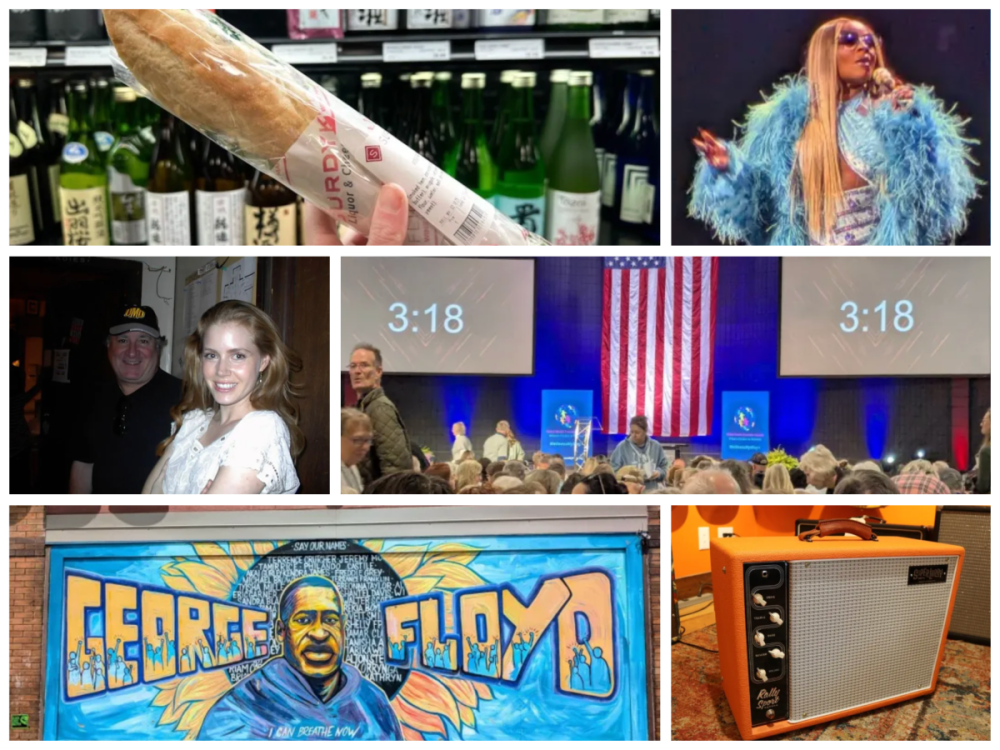Natural disasters scare me more than ever, now that the new Trump administration plans to juice fossil fuel extraction, overflow atmospheric carbon, and trade any prayer at reversing climate change for a fleeting, methane-odored domestic power blitz.
Lucky for me, the city of Minneapolis offers a free disaster preparedness training course called Ready Camp, which I hope can help me stop imagining my tornadic demise and, instead, make a list of go-bag supplies. Turns out doomsday prepping isn’t the exclusive domain of anti-government kooks!
I attended a one-day Ready Camp session on January 22, from 10 a.m. to 4 p.m., at the North Regional Hennepin County Library. Organized by the Minneapolis Emergency Management Department, Ready Camp promises to “make you more resilient, confident, prepared, and secure in a natural or human-caused disaster.” According to LaVina Branscomb, the Emergency Management Department’s communication and outreach coordinator, Ready Camp prepares attendees to make informed decisions about their personal safety and encourages them to share that information with their neighbors and personal networks.
The “camp” in Ready Camp makes me preemptively negative about the day’s activities, like the epistolary protagonist in Allen Sherman’s classic camp spoof “Hello Muddah, Hello Faddah (A Letter from Camp).”
Will I have to participate in a trust fall? Weave a friendship bracelet? Gut a fish inside the library? But when a friendly city of Minneapolis employee welcomes me into the well-lit meeting room, the bright orange folders and nifty whiteboard name tents on the conference table reassure me that, no, I won’t have to engage in any traditional camp activities.
I’m one of seven in-person Ready Campers, along with eight online participants in a Microsoft Teams meeting.The room bustles with city and Hennepin County staff, too. Branscomb welcomes everybody and provides an overview of the Emergency Management Department, a “small but mighty team that provides tools for people to be resilient and equips residents with the information they need.” Then, we Ready Campers introduce ourselves. Ambient anxiety infuses everyone’s reasons for attending the training. Folks mention the recent L.A. fires and New Orleans snowstorm, as well as the 2011 north Minneapolis tornado. I identify closely with Mike, a backpacker with North Woods survival skills looking for tips to improve his urban disaster readiness. Like Mike, I also have a basement cranny stuffed with camping equipment. Unlike Mike, I need at least 10 pounds of gas station ice and a camp chair with an insulated cup holder to survive a weekend wilderness sojourn.
We play BINGO to get to know more about each other. I learn that Ruth, a public health worker, failed her first driver test, that Margo, a community leader, loves country music, and Susan, a Dakota County employee, is a homeowner. I wonder why the BINGO board isn’t survivalist themed? I don’t care who among us knows how to ski. I want to find out who can type an SOS in Morse code, skin a squirrel, or administer a tourniquet.
We start building our disaster preparedness skill sets when Branscomb points us to the family communications plan in our orange folders, which is also available to download online—get it while FEMA’s still kickin’! Disaster preparedness best practices recommend that everyone in a household should memorize the other household members’ phone numbers, plus the same emergency contact. A challenging task for anyone who, like me, has repurposed their phone number memorizing brain space into a receptacle for social media slop.
The communications lecture continues when Danielle Minichino and Tyler Pederson, both 911 call takers, give a presentation about best practices for dialing 911. Call takers and dispatchers need to know your address and what happened, plus it’s important to stay on the line until first responders arrive. I’m pleased to learn that 911 responds to text messages, and in non-violent crises, takes requests for a Behavioral Crisis Response team instead of police.
When we break into teams for a small group exercise, my fellow campers nominate me to keep whiteboard notes. Fair. I’m here for the byline and, not to brag, but if there were an Oscar for handwriting legibility? I’d at least score a nomination. We brainstorm about who we’d communicate with during a disaster and what communication channels to use. No one has a great answer for this stumper: How do you know that a message was received when ordinary communication channels, like cell towers and Wi-Fi, are down? Instead of providing us with a magical walkie-talkie solution, Branscomb suggests that going door-to-door to communicate with neighbors can sometimes be the best option.
I draft some “Mudder Fadder” lyrics about this information gap:
Our climate’s jacked and storms are windy,
If disaster hits the city,
And I don’t know where my family could be,
For how to find them Ready Camp did not prepare me.
Lunch interrupts my misery song satire. Ready Camp treats us to a Mediterranean spread that’s friendly to vegetarians, vegans, and the gluten-free. For dessert, I visit the Minneapolis Regulatory Services Housing Resources table. I ingratiate myself to Karmen Black and Darrell Spears, who work as intermediaries between property owners and renters. They explain how they help in housing disasters like the 2023 Bell Lofts fire while I help myself to a Hershey’s bar from their big plastic bowl filled with fun-size treats. It reminds me of my favorite David Sedaris essay, “You Can’t Kill the Rooster,” in which a hurricane tears through Sedaris’s childhood home and Paul, his younger brother, consoles their father with a pail filled with candy. In my notes where I’m compiling a list of emergency preparedness items, I add “Sedaris Fuck-It Bucket.”
After our feast, Ilana Meisler from the Red Cross educates us on winter weather disaster preparedness. One of her rhetorical questions asks us to imagine ourselves in situations: unsafe home, downed power, bad water, blocked roads, closed stores. As I start to anxiety spiral faster than a storm drain whirlpool in a flash flood, Meisler reminds us that we don’t have to figure it out all at once. The point of the exercise is to break down an evacuation plan into manageable chunks so that, over time, we can figure out two ways to evacuate our homes and neighborhood, determine family member meeting places, and acquire shelter-in-place supplies.
Kellen Schmidt, distribution operations blue hat from Xcel Energy, provides the closest thing to campfire storytime when he begins his safety presentation with an off-script list of electricity don’ts:
- Never plug a generator into your home without reading instructions
- Never DIY an extension cord
- Never use YouTube to train yourself to be an unlicensed electrician
- Never get near a downed wire
“People are doing odd things to get their lights back on,” Schmidt says, ominously, and then continues his presentation on electricity basics and what to do if you encounter a downed power line (stay away!).
National Weather Service lead meteorologist Nick Carletta provides a primer on weather safety. “The average person needs to hear from three sources before taking action in a weather emergency,” Carletta says, so he recommends receiving warnings through multiple channels, like weather apps, a NOAA weather radio, and local broadcast media. His severe weather safety lecture includes tips on surviving extreme cold, winter storms, hail, and tornadoes, plus a bit of Twisters movie trivia. The underpass scene? According to Carletta, who knows about this stuff, it is terrifyingly accurate!
We hear an overview of the Minneapolis Regulatory Services Housing Liaison program from Spears, who tells us, “If your housing is stable, then your life is stable.” Then, adorable PowerPoint pet photos completely upstage Madison Weissenborn’s disaster tips from Minneapolis Animal Care and Control, where she works as the volunteer and community engagement coordinator. Weissenborn stresses the importance of including pets in your evacuation plans. Cat owners, especially, should practice fleeing with their felines, using a high-value treat to behavioral condition them into associating cat carriers with a good time, rather than dreaded vet visits.
Our group’s collective anxiety peaks during Captain David Carson of the Minneapolis Fire Department’s talk on carbon monoxide safety. The L.A. fires rank high on everyone’s worry lists, turning the discussion toward wildfire risk in Minnesota. Carson and Carletta field a number of questions from the group about wildfires, telling us that northern Minnesota is our state’s greatest tinderbox. Grass fires near the Twin Cities are possible, but usually get contained right away.
Near the close of Ready Camp, when Meghan Burian, a senior public health specialist on the Emergency Preparedness and Response team, hands me a swag bag intended to start my at-home disaster kit, I assess whether I feel more resilient. I haven’t acquired any extra survival skills, but I have gained a more realistic picture of what risks I’m likely to face in Minneapolis, rather than the dystopia of my overactive imagination. And I’m leaving with a solid to-do list: I need to memorize phone numbers, buy a NOAA radio, practice evacuation plans with my kids and dog, and stock emergency supplies. Best of all, after meeting all of the safety-minded professionals who work for the city, county, and federal agencies here in the Twin Cities, I feel like I’m in the best place to survive the next four years.
As I leave Ready Camp, I hum an addendum verse:
When the MAGA and the Trumpies’
World-ending schemes give me the grumpies,
I think of all the experts
Working hard to keep us safe from weather that hurts.
Ready Camp sessions are held quarterly and registration is available via the city’s website. Interested in a free lunch and more Minneapolis information? Attend the upcoming Community Connections Conference this Saturday at the Minneapolis Convention Center.







